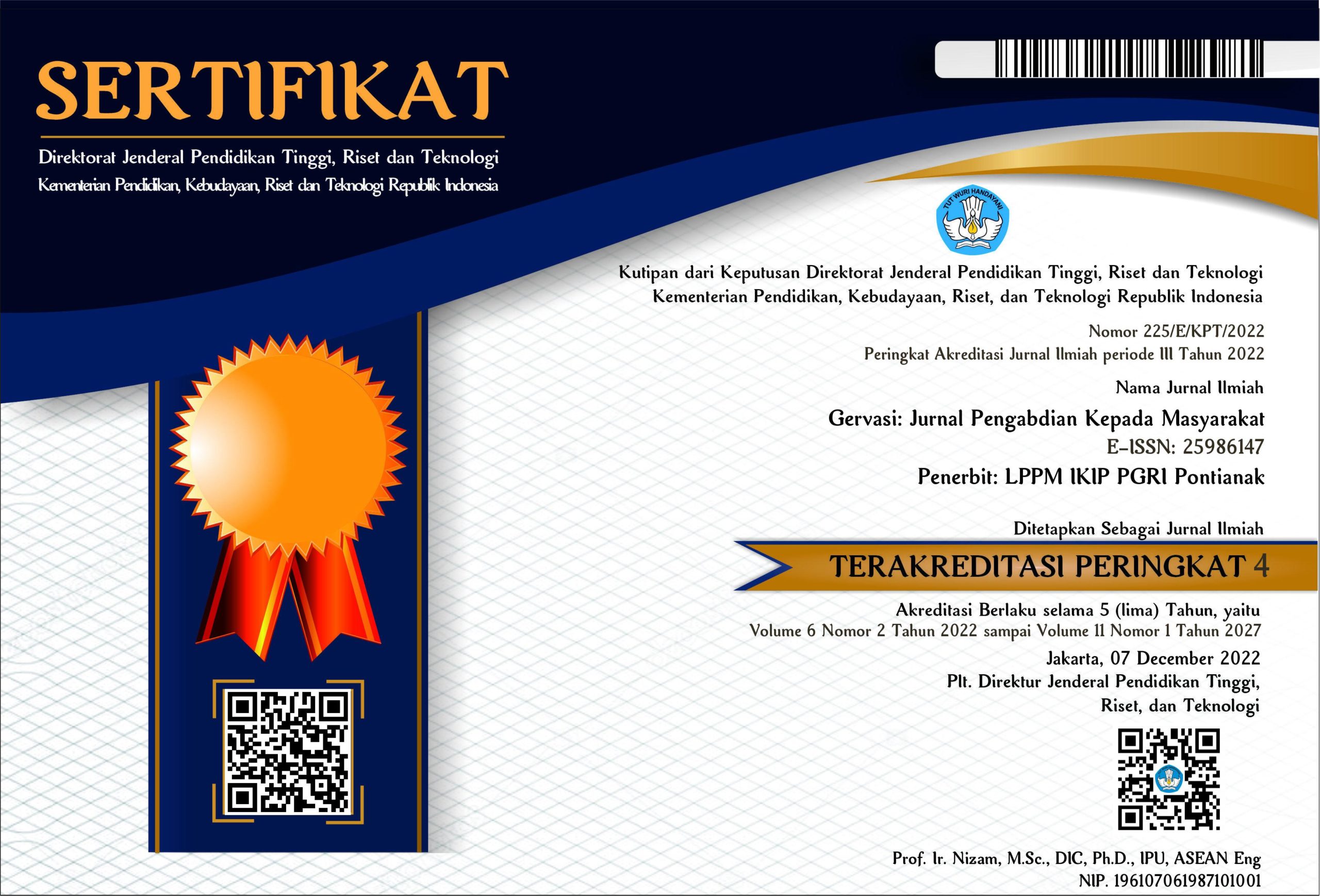MEMBANGUN MINAT PESERTA DIDIK KAMPUNG INGGRIS PARIT BARU DALAM BELAJAR BAHASA INGGRIS
DOI:
https://doi.org/10.31571/gervasi.v4i2.1907Keywords:
membangun minat belajar bahasa Inggris, kampung Inggris, bernyanyiAbstract
Program Studi Pendidikan Bahasa Inggris mengadakan program pengabdian kepada masyarakat yaitu membangun minat peserta didik Kampung Inggris Parit Baru dalam belajar Bahasa Inggris. 137 peserta didik Kampung Inggris Parit Baru terlibat. Kegiatan ini dilakukan dari tanggal 22, 29 Pebruari, 7 dan 14 Maret 2020 di Kantor Desa Parit Baru, Kubu Raya. Catatan lapangan yang telah dianalisis secara tematik menunjukkan bahwa aktivitas bernyanyi yang menggunakan gerakan fisik tidak hanya berguna untuk mengajarkan Bahasa Inggris namun juga membangun minat peserta didik dalam belajar Bahasa Inggris. Rasa ingin tahu yang timbul dengan memberikan variasi pada materi ajar juga membantu membangun minat mereka. Dapat disimpulkan bahwa program pengabdian kepada masyarakat telah berhasil membantu membangun minat preserta didik dalam belajar Bahasa Inggris.
Downloads
References
Archer, A. L., & Hughes, C. A. (2011). Explicit instruction: Effective and efficient teaching. Dalam Exploring the foundations of explicit instruction (hlm. 1–22). Guilford Press.
Aunurrahman, A., Hafis, M., & Sahrawi, S. (2020). Pelatihan menghadapi berita palsu di era revolusi industri 4.0 di Kabupaten Kubu Raya. GERVASI: Jurnal Pengabdian Kepada Masyarakat, 3(2), 241–253. https://doi.org/10.31571/gervasi.v3i2.1575
Aunurrahman, Hamied, F. A., & Emilia, E. (2017). A joint construction practice in an academic writing course in an Indonesian university context. Celt (A Journal of Culture, English Language Teaching & Literature), 17(1), 27–44. https://doi.org/10.24167/celt.v17i1.1137
Fraenkel, J. R., Wallen, N. E., & Hyun, H. H. (2011). How to design and evaluate research in education (8 ed.). McGraw-Hill Humanities/Social Sciences/Languages.
Frankel, K. K. (2013). Revisiting the role of explicit genre instruction in the classroom. Journal of Education, 193(1), 17–30. https://doi.org/10.1177/002205741319300103
Harackiewicz, J. M., & Hulleman, C. S. (2010). The importance of interest: The role of achievement goals and task values in promoting the development of interest. Social and Personality Psychology Compass, 4(1), 42–52. https://doi.org/10.1111/j.1751-9004.2009.00207.x
Harackiewicz, J. M., Smith, J. L., & Priniski, S. J. (2016). Interest matters: The importance of promoting interest in education. Policy insights from the behavioral and brain sciences, 3(2), 220–227. https://doi.org/10.1177/2372732216655542
Hasan, A., Othman, Z., & Mohd Majzub, R. (2015). Using active, creative, effective and joyful (ACEJ) learning strategies toward English achievement and their behavioural changes among primary school students. Mediterranean Journal of Social Sciences, 6(6). https://doi.org/10.5901/mjss.2015.v6n6p455
Lindt, S. F., & Miller, S. C. (2018, Agustus 24). Movement and learning in elementary school. Phi Delta Kappan. https://kappanonline.org/lindt-miller-movement-learning-elementary-school-physical-activity/
Montgomery, A., & Smith, K. M. (2014). Together in song: Building literacy relationships with song-based picture books. Language and Literacy, 16(3), 27–53. https://doi.org/10.20360/G23886
Murayama, K., FitzGibbon, L., & Sakaki, M. (2019). Process account of curiosity and interest: A reward-learning perspective. Educational Psychology Review, 31(4), 875–895. https://doi.org/10.1007/s10648-019-09499-9
Oudeyer, P.-Y., Gottlieb, J., & Lopes, M. (2016). Intrinsic motivation, curiosity, and learning. Dalam Progress in Brain Research (Vol. 229, hlm. 257–284). Elsevier. https://doi.org/10.1016/bs.pbr.2016.05.005
Snyder, K., Dinkel, D., Schaffer, C., & Colpitts, A. (2017). Purposeful movement: The integration of physical activity into a Mathematics unit. International Journal of Research in Education and Science, 3(1), 75–87.
Super Simple Songs. (2019, Agustus 29). Hello! | featuring The Super Simple Puppets | Super Simple Songs—YouTube. Youtube. https://www.youtube.com/watch?v=32ysrBC6B6k
Wikipedia. (2020a). Head, Shoulders, Knees and Toes. https://en.wikipedia.org/w/index.php?title=Head,_Shoulders,_Knees_and_Toes&oldid=935418237
Wikipedia. (2020b). If You’re Happy and You Know It. https://en.wikipedia.org/w/index.php?title=If_You%27re_Happy_and_You_Know_It&oldid=944914306
Downloads
Published
How to Cite
Issue
Section
License
Authors who publish with this journal agree to the following terms:
- Authors retain copyright and grant the journal right of first publication with the work simultaneously licensed under a Creative Commons Attribution License (CC BY-SA 4.0) that allows others to share the work with an acknowledgment of the work's authorship and initial publication in this journal.
- Authors are able to enter into separate, additional contractual arrangements for the non-exclusive distribution of the journal's published version of the work (e.g., post it to an institutional repository or publish it in a book), with an acknowledgment of its initial publication in this journal.
- Authors should sign the copyright transfer agreement when they have approved the final proofs sent by GERVASI prior to the publication.








